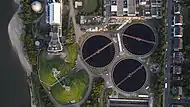Water supply and sanitation in Mali
Water supply and sanitation in Mali is characterized by serious challenges. Having unclean water can lead to many diseases that can potentially become fatal.[1]
Childhood diarrhea
One major water-borne disease that affects the children population of Mali is childhood diarrhea. Childhood diarrhea is the primary cause of death for children in Mali.[1] Many projects and research have been done in order to intervene and help reduce this problem. However, the numbers of children dying from waterborne diseases in Mali has actually risen.[1]
Improved hygiene
Studies have shown that improved hygiene has been effective in decreasing the mortality rate, a percentage that is incredibly high at 45% in some cases.[1] It showed that improved hygiene was twice as effective at reducing waterborne diseases than improved drinking water sources.[1] Improved water drinking sources was not as successful due to recontamination that may occur in a household, which can happen through situations such as water handling or the way water is stored.[1]
Challenges
Open defecation
A common issue that occurs in Mali is open defecation.[2] Over half of the people that do not have access to safe water live in rural areas.[3] Diseases can easily be spread when fecal matter contaminates water sources, such as groundwater. The villagers can then easily drink the contaminated water or use it when preparing food.[2] This may lead to villagers having diarrhea, which can further worsen malnutrition, which is already a problem in Mali.
Water quality at public institutions
Water sanitation and quality is also a problem at hospitals in Mali where water is not clean and toilets are not safe for women. In fact, those are in the list of the top five killers of women worldwide.[4] Women who are about to deliver are at great risk of complications due to health centers being unable to prevent many infections.[4] They often have to relieve themselves outside because public restrooms are not available.[4] Only 20% of health facilities in Mali were reported to have clean water.[4] The same situation arises when it comes to Malian schools. Only 57 percent of schools provide some sort of sanitation facility, an even smaller percentage of that provides students with separate gender restrooms.[5]
References
- Halvorson, Williams, Ba, & Dunkel. (2011). Water quality and waterborne disease in the Niger River Inland Delta, Mali: A study of local knowledge and response. Health and Place, 17(2), 449-457.
- Africa's Water and Sanitation Infrastructure: Access, Affordability, and Alternatives. World Bank Publications. 1 January 2011. pp. 68–69. ISBN 978-0-8213-8618-7. Retrieved 15 December 2018.
- Pickering, Djebbari, Lopez, Coulibaly, & Alzua (2015). "Effect of a community-led sanitation intervention on child diarrhoea and child growth in rural Mali: a cluster-randomised controlled trial". The Lancet Global Health. 3 (11): e701-11. doi:10.1016/S2214-109X(15)00144-8. PMID 26475017.CS1 maint: multiple names: authors list (link)
- Lamble, Lucy (March 17, 2015). "Lack of Safe Water, Sanitation and Soap 'an Embarrassment' Says WHO; Access to Water Is a Crisis That Can Be Fixed, Says Report That Calls for It to Be a Priority in Sustainable Development Goals. We Look at Mali, the Poorest Performer". The Guardian.
- "Water, Sanitation and Hygiene". UNICEF.
